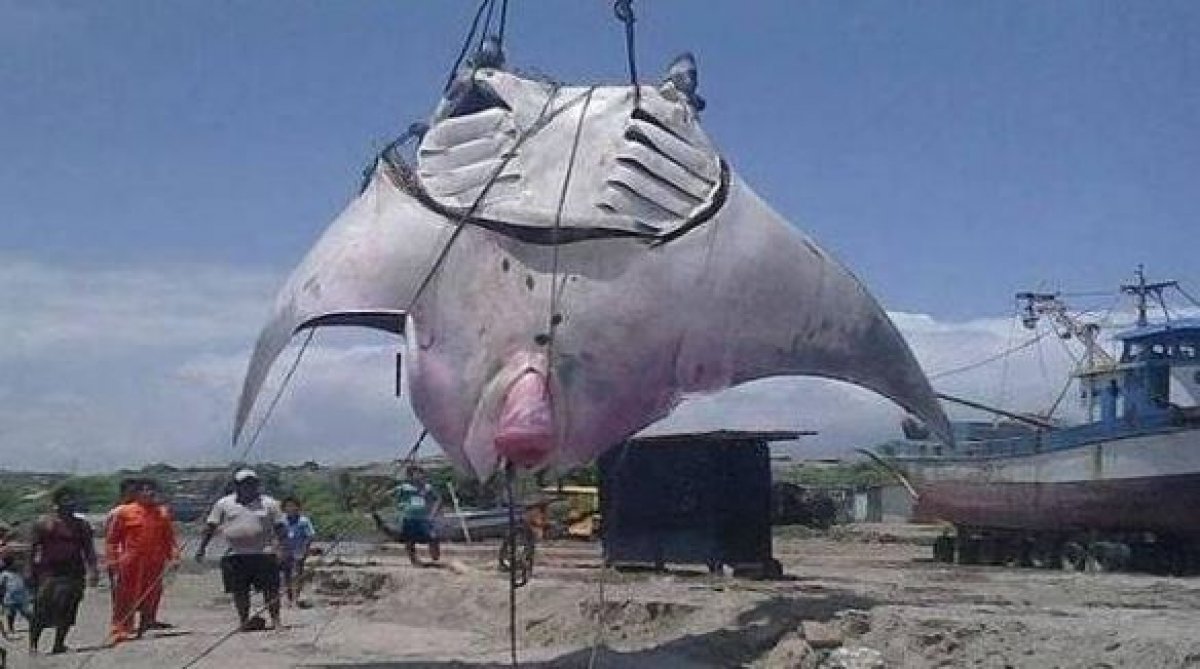
Last week a fisherman in northwestern Peru caught an enormous manta ray, and photos of the dead, bloody animal have angered conservationists around the world.
The fishermen accidentally caught the animal—a giant oceanic manta ray (Manta birostris)—likely while using a device called a gill net in northwest Peru, says researcher Daniel Fernando. Fishermen use gill nets to catch tuna and billfish but the gear often snag larger animals like rays, he adds.
The conservation nonprofit he works for, Manta Trust, advocates for using small nets for catching specific schools of fish or rod-and-reel fishing, which can much better target individual species. These methods have caught on in the Maldives, which currently brings in more than $8 million in tourism related to manta rays alone, he says.
The case highlights the problem of bycatch, the accidental entanglement and killing of animals like rays, sharks and large mammals such as whales and dolphins, in nets meant to catch smaller animals. This has helped drive down the numbers of manta and mobular rays far enough that they are now considered vulnerable (a classification second to "endangered") by the International Union for Conservation of Nature, an environmental group.
Fishermen also increasingly seek out rays for their gill plates, which the Chinese value for their supposed medicinal value, says Fernando, who is also a doctoral student at Linnaeus University in Sweden studying the biology and ecology of mobular and manta rays in the Indian Ocean.
An environmental group called WildAid calculates that the gill plate trade brings in $30 million per year; however, manta ray tourism brings in $140 million worldwide. Thus rays are worth more alive than dead.

In this case, the unlucky ray, was reportedly sold for a pittance, many times less than the price people pay for tuna and other desired species, Fernando says.
On the other hand, Manta Trust has already helped train half a dozen fishermen in the area to make a living off rays in a different way: by taking tourists out to see the animals, to snorkel and swim with, he says. The Manta Trust partnered in this project with a local NGO called Planeta Océano and WildAid, and was funded in part by the Disney Worldwide Conservation Fund.
The ray in the photograph likely measured around 20 to 23 feet wide, says Fernando, and reports claim it weighed more than 2,200 pounds. This is a large ray, but they can get bigger, he adds.
Manta rays are particularly vulnerable to fishing because they reproduce slowly; they take 10 to 15 years to become mature, and give birth to one pup every two to seven years, says Fernando's colleague Josh Stewart.
In 1975, Peru ratified the Convention on International Trade in Endangered Species of Wild Fauna and Flora (CITES), which regulates the export and import of some oceanic rays, banning the trade of mantas without proper permits. Another agreement called the Convention on Migratory Species recently added manta rays to its list of protected animals in 2011, which Peru is a party to.
Stewart says Peruvian fishermen don't seem to be trying to catch mantas, as the animals "typically damage or destroy their nets, and trying to cut a manta free once it's entangled can be dangerous from the small boats they use."
Once a fishermen catch a few rays, he adds, "the entire artisanal fishing fleet tends to avoid that area and move to areas with fewer manta sightings and catches."
Uncommon Knowledge
Newsweek is committed to challenging conventional wisdom and finding connections in the search for common ground.
Newsweek is committed to challenging conventional wisdom and finding connections in the search for common ground.
About the writer
Douglas Main is a journalist who lives in New York City and whose writing has appeared in the New York ... Read more
To read how Newsweek uses AI as a newsroom tool, Click here.






